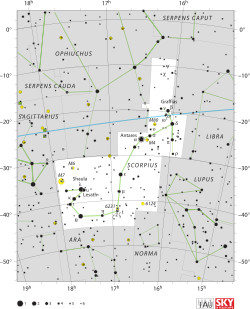Mu1 Scorpii

| |
| Observation data Epoch J2000 Equinox J2000 | |
|---|---|
| Constellation | Scorpius |
| Right ascension | 16h 51m 52.23111s[1] |
| Declination | −38° 02′ 50.5694″[1] |
| Apparent magnitude (V) | +3.04[2] |
| Characteristics | |
| Spectral type | B1.5 V + B6.5 V[3] |
| U−B color index | –0.859[2] |
| B−V color index | –0.202[2] |
| Astrometry | |
| Radial velocity (Rv) | –25[4] km/s |
| Proper motion (μ) | RA: –10.58[1] mas/yr Dec.: –22.06[1] mas/yr |
| Parallax (π) | 6.51 ± 0.91[1] mas |
| Distance | approx. 500 ly (approx. 150 pc) |
| Absolute magnitude (MV) | –2.9 ± 0.3[3] |
| Orbit[3] | |
| Period (P) | 1.44627 days |
| Semi-major axis (a) | 12.90 ± 0.04 R☉ |
| Eccentricity (e) | 0.0 |
| Inclination (i) | 65.4 ± 1° |
| Periastron epoch (T) | 2412374.434 HJD |
| Details | |
| μ1 Sco A | |
| Mass | 8.49 ± 0.05[3] M☉ |
| Radius | 4.07 ± 0.05[3] R☉ |
| Temperature | 23,725 ± 500[3] K |
| μ1 Sco B | |
| Mass | 5.33 ± 0.05[3] M☉ |
| Radius | 4.38 ± 0.05[3] R☉ |
| Temperature | 16,850 ± 500[3] K |
| Other designations | |
- For other star systems with this Bayer designation, see Mu Scorpii.
Mu1 Scorpii (μ1 Sco, μ1 Scorpii) is a binary star system in the southern zodiac constellation of Scorpius. The combined apparent visual magnitude of the pair is +3.04,[2] making it one of the brighter members of Scorpius. Based upon parallax measurements, the distance of this system from the Earth is roughly 500 light years (150 parsecs).[1] This system is a member of the Scorpius-Centaurus Association, the nearest OB association of co-moving stars to the Sun.[3]
μ1 Scorpii is an eclipsing binary of the Beta Lyrae type. Discovered to be a spectroscopic binary by Solon Irving Bailey in 1896, it was only the third such eclipsing pair to be discovered. This is a semidetached binary system where the secondary is close to filling its Roche lobe, or it may even be overflowing. The two stars revolve each other along a circular orbit with the components separated by 12.9 times the radius of the Sun.[3] Due to occultation of each component by the other, the apparent magnitude of the system decreased by 0.3 and 0.4 magnitudes over the course of the binary's orbit, which takes 34 hours 42.6 minutes to complete.
The primary component is a B-type main sequence star with a stellar classification of B1.5 V. It has 8.5 times the mass of the Sun and 4.1 times the Sun's radius. The secondary member is a smaller B-type main sequence star with a classification of about B6.5 V, having 5.3 times the Sun's mass and 4.4 times the radius of the Sun. The effective temperature of the outer atmosphere for each star is 23,725 K for the primary and 16,850 K for the secondary.[3] At these temperatures, the two stars glow with a blue-white hue.[5]
References
- 1 2 3 4 5 6 van Leeuwen, F. (November 2007), "Validation of the new Hipparcos reduction", Astronomy and Astrophysics, 474 (2): 653–664, arXiv:0708.1752
 , Bibcode:2007A&A...474..653V, doi:10.1051/0004-6361:20078357
, Bibcode:2007A&A...474..653V, doi:10.1051/0004-6361:20078357 - 1 2 3 4 Gutierrez-Moreno, Adelina; Moreno, Hugo (June 1968), "A photometric investigation of the Scorpio-Centaurus association", Astrophysical Journal Supplement, 15: 459, Bibcode:1968ApJS...15..459G, doi:10.1086/190168
- 1 2 3 4 5 6 7 8 9 10 11 12 van Antwerpen, C.; Moon, T. (January 2010), "New observations and analysis of the bright semidetached eclipsing binary μ1 Sco", Monthly Notices of the Royal Astronomical Society, 401 (3): 2059–2066, arXiv:0910.1241
 , Bibcode:2010MNRAS.401.2059V, doi:10.1111/j.1365-2966.2009.15796.x
, Bibcode:2010MNRAS.401.2059V, doi:10.1111/j.1365-2966.2009.15796.x - ↑ Wilson, Ralph Elmer (1953), General Catalogue of Stellar Radial Velocities, Washington: Carnegie Institution of Washington, Bibcode:1953GCRV..C......0W
- ↑ "The Colour of Stars", Australia Telescope, Outreach and Education, Commonwealth Scientific and Industrial Research Organisation, December 21, 2004, retrieved 2012-01-16